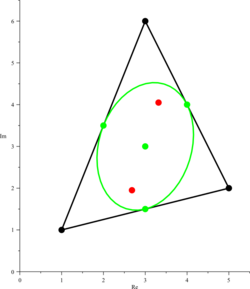Marden's theorem

In mathematics, Marden's theorem, named after Morris Marden but proved about 100 years earlier by Jörg Siebeck, gives a geometric relationship between the zeroes of a third-degree polynomial with complex coefficients and the zeroes of its derivative. See also geometrical properties of polynomial roots.
Statement
A cubic polynomial has three zeroes in the complex number plane, which in general form a triangle, and the Gauss–Lucas theorem states that the roots of its derivative lie within this triangle. Marden's theorem states their location within this triangle more precisely:
- Suppose the zeroes z1, z2, and z3 of a third-degree polynomial p(z) are non-collinear. There is a unique ellipse inscribed in the triangle with vertices z1, z2, z3 and tangent to the sides at their midpoints: the Steiner inellipse. The foci of that ellipse are the zeroes of the derivative p'(z).
Proof
This proof comes from an exercise in Fritz Carlson’s book “Geometri” (in Swedish, 1943).[1]
Given any with , define , then . Thus, we have
and similarly for and . In other words, by a linear change of variables, we may perform arbitrary translation, rotation, and scaling on the roots of and .
Thus, WLOG, we let the Steiner inellipse's focal points be on the real axis, at , where is the focal length. Let be the long and short semiaxis lengths, so that .
Let the three roots of be for .
Horizontally stretch the complex plane so that the Steiner inellipse becomes a circle of radius . This would transform the triangle into an equilateral triangle, with vertices .
By geometry of the equilateral triangle, , we have , thus by Vieta's formulas (for notational cleanness, we "loop back" the indices, that is, .). Now it remains to show that ,
Since , it remains to show , that is, it remains to show
By the geometry of the equilateral triangle, we have , and for each , which implies
which yields the desired equalities.
Additional relations between root locations and the Steiner inellipse
By the Gauss–Lucas theorem, the root of the double derivative p"(z) must be the average of the two foci, which is the center point of the ellipse and the centroid of the triangle. In the special case that the triangle is equilateral (as happens, for instance, for the polynomial p(z) = z3 − 1) the inscribed ellipse becomes a circle, and the derivative of p has a double root at the center of the circle. Conversely, if the derivative has a double root, then the triangle must be equilateral (Kalman 2008a).
Generalizations
A more general version of the theorem, due to (Linfield 1920), applies to polynomials p(z) = (z − a)i (z − b)j (z − c)k whose degree i + j + k may be higher than three, but that have only three roots a, b, and c. For such polynomials, the roots of the derivative may be found at the multiple roots of the given polynomial (the roots whose exponent is greater than one) and at the foci of an ellipse whose points of tangency to the triangle divide its sides in the ratios i : j, j : k, and k : i.
Another generalization ((Parish 2006)) is to n-gons: some n-gons have an interior ellipse that is tangent to each side at the side's midpoint. Marden's theorem still applies: the foci of this midpoint-tangent inellipse are zeroes of the derivative of the polynomial whose zeroes are the vertices of the n-gon.
History
Jörg Siebeck discovered this theorem 81 years before Marden wrote about it. However, Dan Kalman titled his American Mathematical Monthly paper "Marden's theorem" because, as he writes, "I call this Marden’s Theorem because I first read it in M. Marden’s wonderful book".
Marden (1945, 1966) attributes what is now known as Marden's theorem to (Siebeck 1864) and cites nine papers that included a version of the theorem. Dan Kalman won the 2009 Lester R. Ford Award of the Mathematical Association of America for his 2008 paper in the American Mathematical Monthly describing the theorem.
See also
- Bôcher's theorem for rational functions
References
- Kalman, Dan (2008a), "An Elementary Proof of Marden's Theorem", The American Mathematical Monthly 115 (4): 330–338, doi:10.1080/00029890.2008.11920532, ISSN 0002-9890, http://mathdl.maa.org/mathDL/22/?pa=content&sa=viewDocument&nodeId=3338&pf=1
- Kalman, Dan (2008b), "The Most Marvelous Theorem in Mathematics", Journal of Online Mathematics and Its Applications, http://mathdl.maa.org/mathDL/4/?pa=content&sa=viewDocument&nodeId=1663
- Linfield, B. Z. (1920), "On the relation of the roots and poles of a rational function to the roots of its derivative", Bulletin of the American Mathematical Society 27: 17–21, doi:10.1090/S0002-9904-1920-03350-1.
- Marden, Morris (1945), "A note on the zeroes of the sections of a partial fraction", Bulletin of the American Mathematical Society 51 (12): 935–940, doi:10.1090/S0002-9904-1945-08470-5, https://www.ams.org/bull/1945-51-12/S0002-9904-1945-08470-5/home.html
- Marden, Morris (1966), Geometry of Polynomials, Mathematical Surveys, 3, Providence, R.I.: American Mathematical Society; reprint of 1949 original publication; 2005 pbk reprint with corrections
- Parish, James L. (2006), "On the derivative of a vertex polynomial", Forum Geometricorum 6: 285–288: Proposition 5, http://forumgeom.fau.edu/FG2006volume6/FG200633.pdf
- Siebeck, Jörg (1864), "Über eine neue analytische Behandlungweise der Brennpunkte", Journal für die reine und angewandte Mathematik 64: 175–182, ISSN 0075-4102, http://gdz.sub.uni-goettingen.de/dms/load/img/?PPN=GDZPPN002152495 hathitrust link
 |
